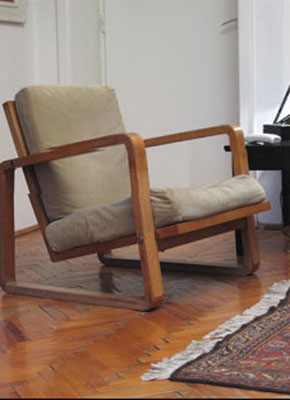The period of the Kingdom of Serbs, Croats and Slovenes (1918-1929) The period of the Kingdom of Yugoslavia (1929-1941)
MODERNISM IN ARCHITECTURE
Along with socially engaged art in the fine arts of Bosnia and Herzegovina, primarily expressed in the works of Roman Petrović and especially in his cycle of paintings "Children on the Streets", and Vojo Dimitrijević, with his painting "Spain" done in 1937, the most important artistic trend of the period was modernism in architecture and design. The most prominent figures were the Prague students - brothers Reuf and Muhamed Kadić, as well as Jahiel Finci, who would, by mid-20th century, pave the way for the development of modern architecture in the country. In 1939, Juraj Neidhart, who was a disciple of Peter Behrens in Vienna and who later collaborated with Le Corbusier, came to Sarajevo. After the Second World War, together with Dušan Grabrijan, he initiated what would become known as "the Bosnian style in architecture". Independently from them, the Srebrenica-born Selman Selmanagić, obtained his education at Bauhaus and graduated there in 1933 (as the great school's 100th graduate). He thus became the first student from the Balkans who completed his studies at this school. His life journey and his creative and pedagogical career in the domains of design and architecture were mostly linked to Berlin and (after WWII) to East Germany.
BOSNIAN STYLE OF FURNITURE DESIGN BETWEEN TWO WORLD WAR
Adem Nikšić was the founder (1927) and owner of the "first and the most precise walnut wood engravingworkshop", in Konjic; his intention was to make furniture in Bosnian-Arabic and Constantinople Style (vine tree). The shop has continued cultivating traditional craft of wood engraving in Bosnia and Herzegovinain the production of furniture. As of 1996, the workshop operates under the name Braća Nikšić, and today it is known as Rukotvorine. Since 2014, the firm has begun developing their own brand - Zanat - engaging wellknown Bosnian (Salih Teskeredžić, Jasna Mujkić) and foreign designers (Monica Forster and Gert Wingardh from Sweden and Harri Koskinen from Finland). The result of the superb quality of their furniture is proven by numerous design awards won in the recent years at the furniture fairs in Köln, New York, Stockholm, and others.
NORBERT and WALTER NEUGEBAUER
Jack Jackson and Bimbo Bambus in African jungle (above), Mickey strip, Zagreb, 1938. The adventures of Diko Izvidnik (below), Novi vandrokaš, Zagreb 1938/39. Brothers Norbert (1917) and Walter (1921) Neugebauer were born in Tuzla. As boys, together with their parents, they moved to Zagreb, where, at the age of 15-16, as grammar school pupils, they published their first illustrations and cartoons. Norbert wrote scenarios and texts, while Walter did the drawing. They published their first works in Oko (Popaye and Coconut, Adventures of Nasredin-hodža) between 1935 and 1937, and then started publishing in numerous magazines and reviews (Novosti, Veseli zabavnik, Mickey strip, Veseli vandrokaš, Zabavnik, Patak, Kerempuh, Ilustrirani zabavnik, Horizontov zabavnik, VUS, Petko, Plavi Vjesnik, etc.), creating many characters (Patuljak Nosko, Bimbo Bambus, Srećko, etc.). Walter Neugebauer's talent was very versatile. At the beginning, in cartoons showing animals, he was influenced by his great role model, Walt Disney, but later - in stories and cartoons showing figures of children and adult heroes, he demonstrated original gift and developed a recognizable method of animation (the character of his heroes, story-line and the direction). Under Walter's guiding, Duga Film from Zagreb realised the first professional 22 minutes-long animation film titled Veliki miting (The Great Rally) in 1951. This film is a point of reference in the birth and development of the Zagreb School of Animation Film.
Adem Nikšić was the founder (1927) and owner of the "first and the most precise walnut wood engravingworkshop", in Konjic; his intention was to make furniture in Bosnian-Arabic and Constantinople Style (vine tree). The shop has continued cultivating traditional craft of wood engraving in Bosnia and Herzegovinain the production of furniture. As of 1996, the workshop operates under the name Braća Nikšić, and today it is known as Rukotvorine.
Along with socially engaged art in the fine arts of Bosnia and Herzegovina, primarily expressed in the works of Roman Petrović and especially in his cycle of paintings "Children on the Streets", and Vojo Dimitrijević, with his painting "Spain" done in 1937, the most important artistic trend of the period was modernism in architecture and design.



